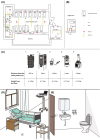SARS-CoV-2 indoor environment contamination with epidemiological and experimental investigations
- PMID: 36305066
- PMCID: PMC9828560
- DOI: 10.1111/ina.13118
SARS-CoV-2 indoor environment contamination with epidemiological and experimental investigations
Abstract
SARS-CoV-2 has been detected both in air and on surfaces, but questions remain about the patient-specific and environmental factors affecting virus transmission. Additionally, more detailed information on viral sampling of the air is needed. This prospective cohort study (N = 56) presents results from 258 air and 252 surface samples from the surroundings of 23 hospitalized and eight home-treated COVID-19 index patients between July 2020 and March 2021 and compares the results between the measured environments and patient factors. Additionally, epidemiological and experimental investigations were performed. The proportions of qRT-PCR-positive air (10.7% hospital/17.6% homes) and surface samples (8.8%/12.9%) showed statistical similarity in hospital and homes. Significant SARS-CoV-2 air contamination was observed in a large (655.25 m3 ) mechanically ventilated (1.67 air changes per hour, 32.4-421 L/s/patient) patient hall even with only two patients present. All positive air samples were obtained in the absence of aerosol-generating procedures. In four cases, positive environmental samples were detected after the patients had developed a neutralizing IgG response. SARS-CoV-2 RNA was detected in the following particle sizes: 0.65-4.7 μm, 7.0-12.0 μm, >10 μm, and <100 μm. Appropriate infection control against airborne and surface transmission routes is needed in both environments, even after antibody production has begun.
Keywords: SARS-CoV-2; air sample; infection control; neutralizing antibody response; surface sample.
© 2022 The Authors. Indoor Air published by John Wiley & Sons Ltd.
Conflict of interest statement
The authors declare no competing interests.
Figures


References
Publication types
MeSH terms
Substances
LinkOut - more resources
Full Text Sources
Medical
Miscellaneous

